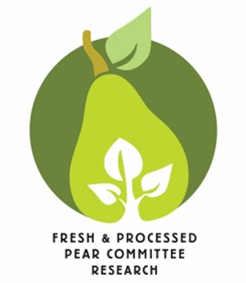Authors: Paige Beuhler, Tory Schmidt, and Ines Hanrahan
Based on the recommendations of the Pear Research Subcommittee (PRSC), the Fresh and Processed Pear Committees (FPC & PPC) approved $255,575 to fund five (5) new pear projects in March 2022.
2022 New Pear Project Details:
Project Title: Pear Psylla Pheromone Lures for Monitoring and Mating Disruption
Organization (s): Oregon State University-Hood River
PI (s): Adams, C.
Total Funding Amount for All Years: $60,000
Length: 3 Years
The main threat posed by pear psylla is the honeydew produced as a by-product of feeding. Even moderate psylla populations can produce enough honeydew to cause black sooty mold and russeting that lowers fruit value and creates sticky conditions that negatively affect workers harvesting fruit. Synthetic sex pheromones have been proven to be highly effective tools for both monitoring populations and for disruption of mating behavior in a dozen key insect pests. However, these tools are currently lacking in the pear industry. Developing pheromone-based tools against pear psylla would represent a novel tactic for managing this key pear pest and benefit both conventional and organic growers.
Objectives
1. Compare pheromone baited monitoring traps to beat tray sampling for measuring early season phenology and action thresholds (Year 1&2).
2. Conduct dose response experiment to determine dispensers per acre needed to reduce catch in monitoring traps (Year 2&3).
Project Title: What Factors Impact Mite Outbreaks in Pear?
Organization (s): USDA-ARS, Washington State University, Oregon State University
PI (s): Schmidt-Jeffris, R.; Nottingham, L.; Adams, C.
Total Funding Amount for All Years: $133,739
Length: 2 Years
Both spider mites and rust mites are reoccurring issues in Northwest pear production. Spider mite outbreaks are typically attributed to applications of pesticides that harm their natural enemies, but dry years, mowing frequency, weed management, dusty road conditions, and the absence of pear psylla (or “good psylla years”) have also been implicated in mite outbreaks. A key first step in developing more sustainable strategies for managing mites is to determine which factors most strongly impact pest mite abundance. If able to identify these factors, they can be used to predict “bad mite years” and to determine which control options are the most promising for reducing mite populations and deserve further testing. The primary goal of this project is to identify factors associated with pest mite outbreaks, including those factors which are associated with low populations of natural enemies. It will also identify which natural enemies are the most important in pest mite management. This will determine if spider mite outbreaks can be predicted and facilitate recommendations regarding practices to avoid to reduce the risk of outbreaks or harm to natural enemies.
Project Title: Pear Rootstock Breeding
Organization (s): Washington State University
PI (s): Evans, K.; Teh, S L.
Total Funding Amount for All Years: $303,018
Length: 3 Years
This proposal aims to build on recent (and concurrent) research to further develop a long-term dedicated pear rootstock breeding program at the WSU Tree Fruit Research and Extension Center, Wenatchee, WA. Research efforts will focus on evaluating current seedling populations for selection and collecting robust phenotypic data that can be integrated with existing genotypic information to facilitate efficient future selection of desirable rootstocks. The long-term priority of this proposal is to “develop dwarfing rootstocks that are suited for high-density pear production” in the Pacific Northwest.
Objectives
1. Develop seedling populations to produce new rootstocks
2. Conduct marker-trait association for rootstock-conferred traits in seedling populations
3. Validate stability/repeatability of preliminary dwarfing locus
4. Maintain a relevant pear rootstock parent germplasm
5. Evaluate B × A and B × C selections
Project Title: Germplasm Evaluation for Fruit Quality and Post-Harvest Traits
Organization (s): USDA-ARS
PI (s): Gottschalk, C.; Collum, T.; Reinhold, L.
Total Funding Amount for All Years $55,000
Length: 3 Years
This proposal aims to thoroughly document uninvestigated traits within the USDA Pyrus
germplasm collection in Kearneysville, WV to complement currently available phenotypic information. The team aims to characterize harvest date, storage and ripening requirements, post-harvest disease resistance, supply chain resilience, and general fruit quality in these pear selections. Linking phenotypic data with genotype can empower researchers in identifying genetics associated with valuable traits and, potentially, accelerate the breeding process. Phenotypic information for the USDA Pyrus germplasm is currently lacking and limits the impact and ability to utilize the genetic information for breeding/genetic improvement of varieties. The results gained from this work will fill a glaring knowledge gap and can be immediately utilized by the USDA ARS breeding program at the Appalachian Fruit Research Station (AFRS) for further pear scion breeding.
Project Title: Ultra-low O2 CA Strategies to reduce d’Anjou Storage Disorders
Organization (s): USDA-ARS, Washington State University
PI (s): Rudell, D.; Mattheis, J.; Torres, C.; Leisso, R.
Total Funding Amount for All Years: $211,242
Length: 3 Years
Controlled atmosphere using less than 1% O2 controls pear ripening and some peel disorders. Rapidly applied (pull down beginning less than a week after placement in storage) CA storage is the only effective ripening and superficial scald control protocol currently acceptable for organically produced apples and pears. A roadblock to widespread use of ULO-CA to store d’Anjou pears is the risk of developing other disorders including black speck and internal browning or pithy brown core. Furthermore, scald can develop when post-storage cold chains last a month or more. ULO CA storage parameters that reduce black speck, internal disorder, and superficial scald risk without compromising ripening control or eating quality would remove an important barrier to safe, effective use of existing ULO CA technology. To accomplish this goal, the team will test techniques they have collectively developed for apples and pears to overcome these and similar issues.
Objectives:
1. Identify temperature/atmospheric combinations that reduce superficial scald without causing other disorders.
2. Determine what post-storage ripening and scald controls can be used following ULO CA.
3. Evaluate tests that indicate disorder control effectiveness during ULO CA.
Contact:
Paige Beuhler (Administrative Officer): paigeb@treefruitresearch.com, 509 665 8271 ext. 2

